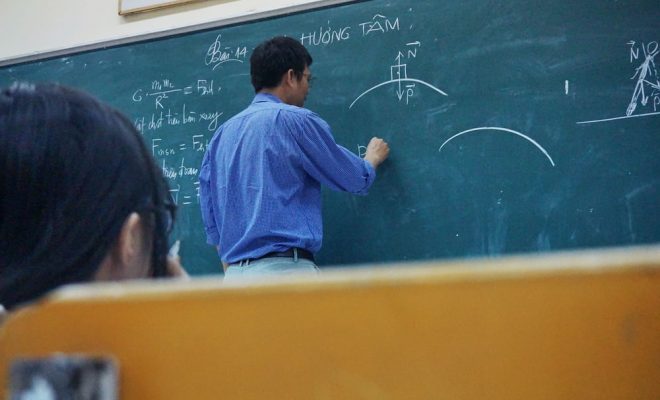Mathematics Terms That Middle School and High School Students Should Know

Of all of the K-12 subjects that I studied, math was my least favorite. Not because I wasn’t a decent math student; the issue was that many of the math teachers that I had throughout my life have been less than stellar. They made their lectures hard to follow and analogous to pulling teeth. Thankfully, I mastered mathematics in spite of this. One of the things that helped me was learning all of the terminology associated with algebra, statistics, trigonometry, etc. and then determining the basic rules that governed each math discipline.
In this article, I will list and define the mathematics terms that middle school and high school students need to know. This is by no means an exhaustive list, but it is close to it. By learning the foundations of math, I hope that your students will parlay this into math fluency.
Acute angle – Is an angle that measures below 90°.
Acute triangle – A triangle is containing only acute angles.
Additive inverse – Opposite of a number or its contrary. A number plus its additive inverse equals 0.
Adjacent angles – Are angles with a common side and vertex.
Angle – Are created by two rays and containing an endpoint in common.
Arc – Set of points that lie on a circle and that are positioned within a central angle.
Area – Apace contained within a shape.
Average – Numerical result of dividing the sum of two or more quantities by the number of quantities.
Binomial – Expression in algebra that consists of two terms.
Bisect – Dividing into two equal sections.
Canceling – In the multiplication of fractions, when one number is divided into both a numerator and a denominator.
Cartesian coordinates – Are ordered number pairs that are assigned to points on a plane.
Chord – Line segment that connects two points on a circle.
Circle – Set of points that are all the same distance from a given location.
Circumference – is the distance measured around a circle.
Coefficient – Number that is placed in front of a variable. For example, in 6x, 6 is the coefficient.
Common denominator – Number that can be divided evenly by all denominators in the problem.
Complementary angles – Are two angles in which the sum of their measurements equals 90°.
Complex fraction – Fraction that contains a fraction or fractions in the numerator and/or denominator.
Congruent – Exactly the same. Identical regarding size and shape.
Coordinate graph – Are two perpendicular number lines, the x-axis and the y-axis, which make a plane upon which each point is assigned to a number pair.
Cube – Solid with six sides, with the sides being equal squares and the edges being equal.
Cube root – Number that when multiplied by itself twice, results in the original number.
Degree – Measurement unit of an angle.
Denominator – Bottom symbol or number of a fraction.
Diameter – Line segment that contains the center and has its endpoints on the circle. Also, the length of this segment.
Difference – That which results from subtraction.
Equation – A relationship between symbols and/or numbers that is balanced.
Equilateral triangle – A triangle that has three equal angles and three sides the same length.
Even number – An integer which can be divided by 2, with no remainder.
Expanded notation – To point out the place value of a digit by writing the number as the digit times its place value.
Exponent – A positive or negative number that expresses the power to which the quantity is to be raised or lowered. It is placed above and to the right of the name.
Exterior angle – In a triangle, an exterior angle is equal to the measures of the two interior angles added together.
Factor – As a noun, it is a number or symbol which divides evenly into a larger number. As a verb, it means to find two or more values whose product equals the original value.
F.O.I.L. Method – A method used for multiplying binomials in which the first terms, the outside terms, the inside terms, and then the last terms are multiplied.
Fraction – A symbol that expresses part of a whole. It contains a numerator and a denominator.
Greatest common factor – The largest factor that is common to two or more numbers.
Hypotenuse – In a right triangle, it is the side opposite from the 90° angle.
Imaginary number – The square root of a negative number.
Improper fraction – A fraction in which the numerator is larger than the denominator.
Integer – A whole number. It may be positive, negative, or zero.
Interior angles – Angles formed inside the shape or inside two parallel lines.
Intersecting lines – Lines that come together at a point.
Interval – The numbers that are contained within two specific boundaries.
Irrational number – Number that is not rational.
Isosceles triangle – A triangle with two equal sides and two equal angles across from them.
Least common multiple – The smallest multiple that is common to two or more numbers.
Linear equation – An equation where the solution set forms a straight line when it is plotted on a coordinate graph.
The lowest common denominator – The smallest number that can be divided evenly by all denominators in the problem.
Mean – The average of a number of items in a group (total the items and divide by the number of items).
Median – Middle item in an ordered group. If the group contains an even number of items, the median is the average of the middle items.
Mixed number – A number containing both a whole number and a fraction.
Monomial – An expression in algebra that consists of only one term.
Natural number – A counting number.
Negative number – A number less than zero.
Nonlinear equation – An equation where the solution set does not form a straight line when it is plotted on a coordinate graph.
Number line – A visual representation of the positive and negative numbers and zero.
Numerator – The top symbol or number of a fraction.
Obtuse angle – An angle that is larger than 90° but less than 180°.
Obtuse triangle – A triangle that contains an obtuse angle.
Odd number – An integer (whole number) that is not divisible evenly by 2.
Ordered pair – Any pair of elements (x,y) where the first element is x, and the second element is y. These are used to identify or plot points on coordinate graphs.
Origin – The intersection point of the two number lines of a coordinate graph. The intersection point is represented by the coordinates (0,0).
Parallel lines – Two or more lines that are always the same distance apart. They never meet.
Percentage – A common fraction with 100 as its denominator.
Perpendicular lines – Two lines that intersect at right angles.
Pi (π) – A constant that is used for determining the circumference or area of a circle. It is equal to approximately 3.14.
Polynomial – An expression in algebra that consists of two or more terms.
Positive number – A number greater than zero.
Power – A product of equal factors. 3 x 3 x 3 = 33, read as “three to the third power” or “the third power of three.” Power and exponent can be used interchangeably.
Prime number – A number that can be divided by only itself and one.
Proper fraction – A fraction in which the numerator is less than the denominator.
Proportion – Written as two equal ratios.
Pythagorean theorem – A theorem concerning right triangles. The sum of the squares of a right triangle’s two legs is equal to the square of the hypotenuse (a2 + b2 = c2).
Quadrants – The four divisions on a coordinate graph.
Quadratic equation – An equation that may be expressed as Ax2 + Bx + C = 0.
Radical sign – A symbol that designates a square root.
Radius – A line segment where the endpoints lie one at the center of a circle and one on the circle. The term also refers to the length of this segment.
Ratio – Comparison between two numbers or symbols. May be written x:y, x/y, or x is to y.
Rational number – An integer or fraction such as 7/7 or 9/4 or 5/1.Number that can be written as a fraction x/y with x a natural number and y an integer.
Reciprocal – The multiplicative inverse of a number. For example, 2/3 is the reciprocal of 3/2.
Reducing – Changing a fraction into its lowest terms. For example, 3/6 is reduced to ½.
Right angle – An angle that measures 90°.
Right triangle – A triangle that contains a 90° angle.
Scalene triangle – A triangle in which none of the sides or angles are equal.
Scientific notation – A number between 1 and 10 and multiplied by a power of 10. Used for writing very large or very small numbers.
Set – A group of objects, numbers, etc.
Simplify – To combine terms into fewer terms.
Solution, or Solution set – The entirety of answers that may satisfy the equation.
Square – The resulting number when a number is multiplied by itself. Also, a four-sided figure with equal sides and four right angles. The opposite sides are parallel.
Square root – The number which, when multiplied by itself, gives you the original number. For example, 6 is the square root of 36.
Straight angle – An angle which is equal to 180°.
Straight-line – The shortest distance between two points. It continues indefinitely in both directions.
Supplementary angles – Two angles that when combined, the sum equals 180°.
Term – A literal or numerical expression that has its own sign.
Transversal – A line that crosses two or more parallel or nonparallel lines in a plane.
Triangle – A three-sided closed figure. It contains three angles that when combined, the sum equals 180°.
Trinomial – An expression in algebra which consists of three terms.
Unknown – A symbol or letter whose value is unknown.
Variable – A symbol that stands for a number.
Vertical angles – The opposite angles that are formed by the intersection of two lines. Vertical angles are equal.
Volume – The amount which can be held, as measured in cubic units. The volume of a rectangular prism = length times width times height.
Whole number – 0, 1, 2, 3, 4, 5, 6, 7, 8, etc.
X-axis – The horizontal axis on a coordinate graph.
X-coordinate – The first number in an ordered pair. It refers to the distance on the x-axis.
Y-axis – The vertical axis on a coordinate graph.
Y-coordinate – The second number in an ordered pair. It refers to the distance on the y-axis.




